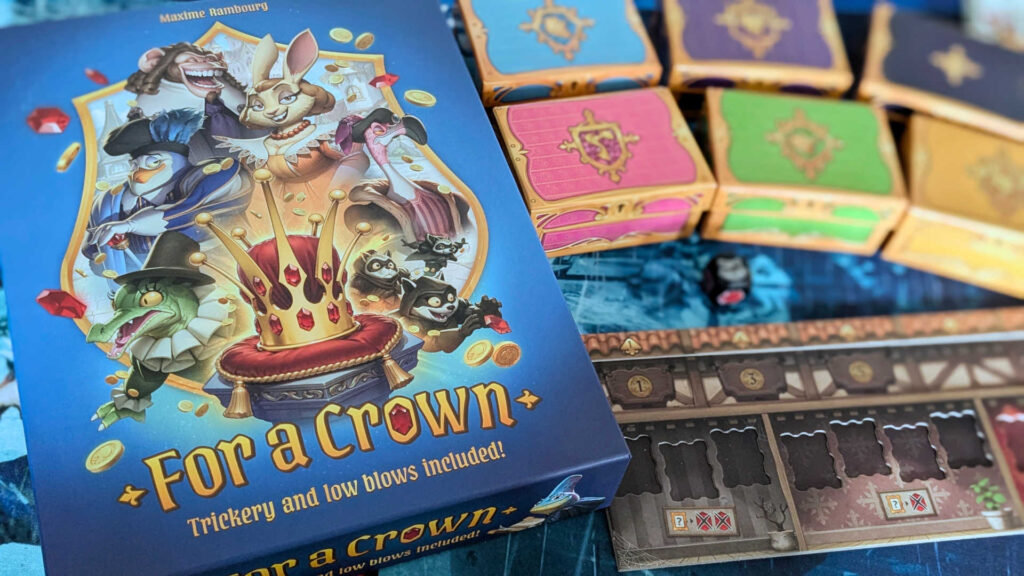Image credits to the author
Deck building games are hugely popular, and new titles in the genre are frequently being released. Examples can be found for players of all skill levels, from absolute beginners (Super Meow) to players looking for a long-running campaign with a huge amount of unlockable content (Slay the Spire: The Board Game). Another example we can add to the list is For a Crown (designed by Maxime Rambourg and published by Repos Production), which puts a unique spin on deck building, with players building a shared, rather than personal, deck over the course of a game.
Does it bring more to the table than just that unique approach? Let’s find out!
Table of Contents
ToggleGetting Started With For a Crown
For a Crown’s setting concerns a group of warring kingdoms, ruled (and populated) by a variety of anthropomorphic animals, who decide that the time to band together and form a single kingdom is long overdue. However, they can’t agree on who should be crowned the first monarch of this new, merged kingdom, and must compete to be the most influential and wealthy family to secure victory.
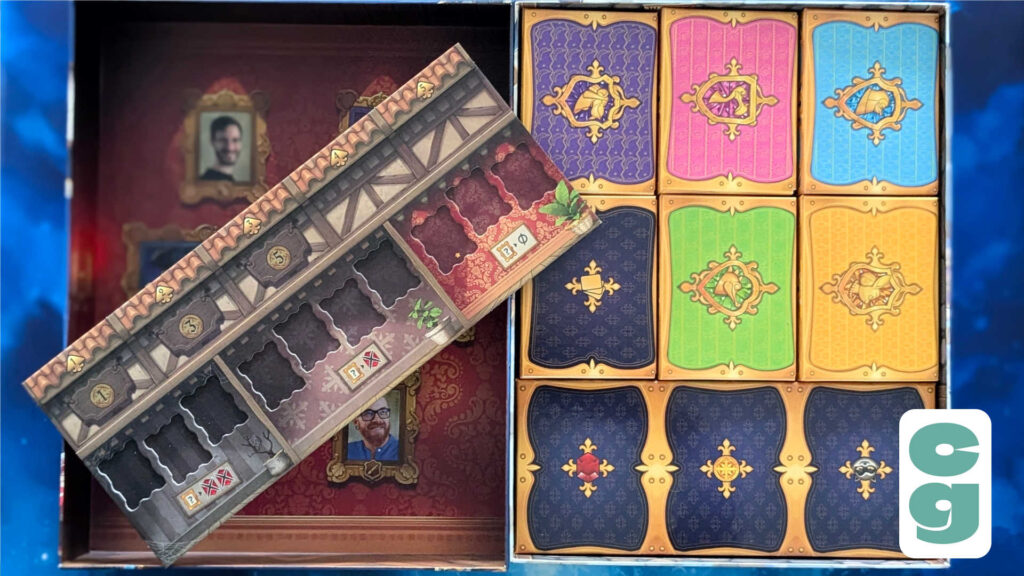
One of the first things you notice when you open For a Crown’s modestly sized (and beautifully illustrated) packaging is how well everything stores in there, as well as just how impressive the components are. As an example, and something that stands out immediately, each family has their own color coded, personalized chest with which to keep their wealth hidden over the course of the game. In an inspired touch, which really speaks to the attention to detail and care lavished upon every element of For a Crown, you’ll even find a special object illustrated in the interior of each chest, relevant to its family’s animal type (a carrot for the rabbit, or a banana for the ape).
In any case, to get started, setup initially looks a bit daunting, with certain event cards starting a shared deck, others going into a different deck, then a “grid” of mercenary cards, known as the Royal Square to deal out into different rows, as well as a cost track and portrait gallery to set up.
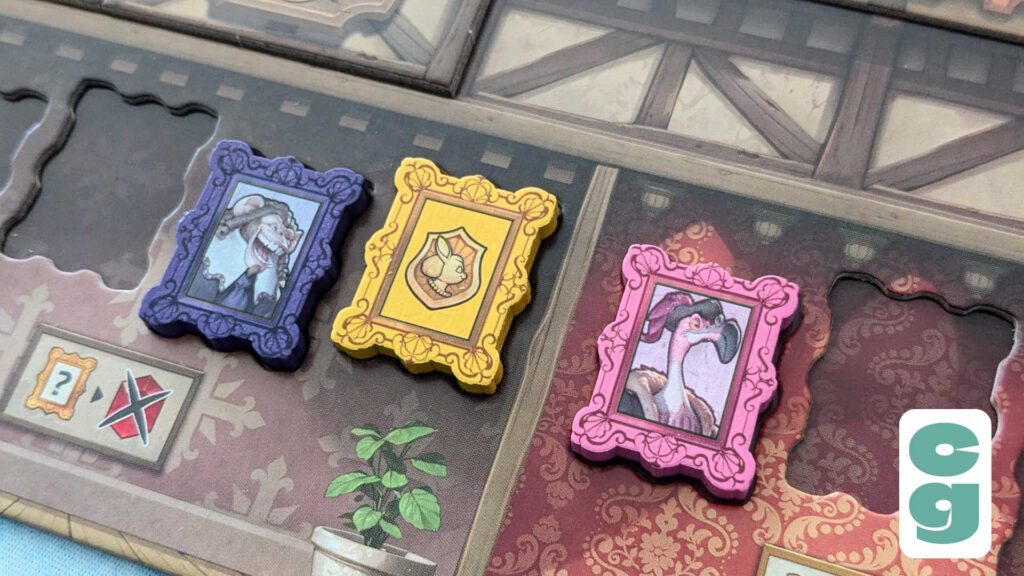
The portrait gallery setup at the beginning of the game (which determines the most influential to the least influential player at any given time) is a bit odd, given that you’re advised to set it up randomly, as this can have a real impact over the first round of the game. However, this is compensated for by the player in the lead starting with the least coins, while the player in the least influential spot gains a coin bonus over everyone else.
Each player has their own set of five card sleeves, which they use when buying mercenaries from the Royal Square, which acts as the game’s marketplace.
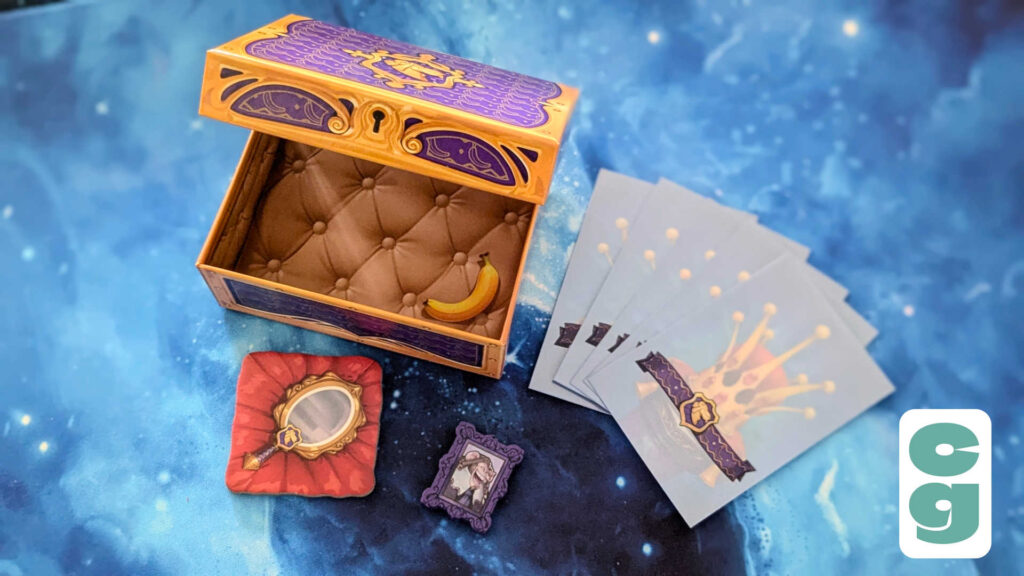
Players also take their aforementioned family chests and place ten rubies, plus their family heirloom and coins, inside it. These are kept secret over the course of the game, so they’re more than just a lavish cosmetic accessory; they allow players to maintain some level of mystery over their position as the game progresses, with the winner being the player who has the most rubies at the end of the fourth round of the game.
How to Play For a Crown
There are three steps to each round of For a Crown: recruit, reveal and end of round. Let’s look at them all in turn.
Recruit
During the recruit phase, players will each buy a card from the Royal Square, in order of most to least influential of players. The most influential player is the one whose portrait token is to the rightmost of all tokens in the gallery, whereas the least influential is the player on the furthest left of all portraits.
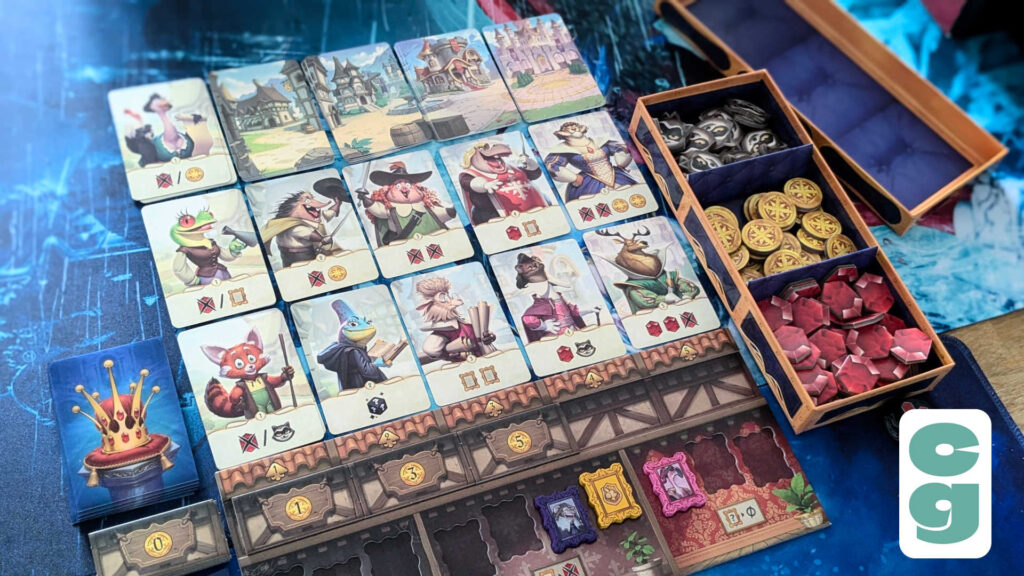
The cost of cards from the Royal Square is determined by the recruitment cost tokens underneath each row; at the outset of the game, the level 1 cards cost one coin, level 2 cards are three coins and level 3 cards are five coins. You’re unable to buy the level 4 and 5 cost cards initially, but each round the values shift one column to the right, with the leftmost column being free to acquire in round 2, then the first two columns being zero cost in round 3, as the 1, 3, and 5 shift to the right each round. Face down cards from the decks in the Royal Square can be purchased for the same cost as others in the column, but other players won’t see what’s on that card until later.
Cards can be purchased with a combination of coins and rubies, with rubies being equivalent to one coin each. Of course, rubies also double as victory points, so it pays to spend coins whenever possible!
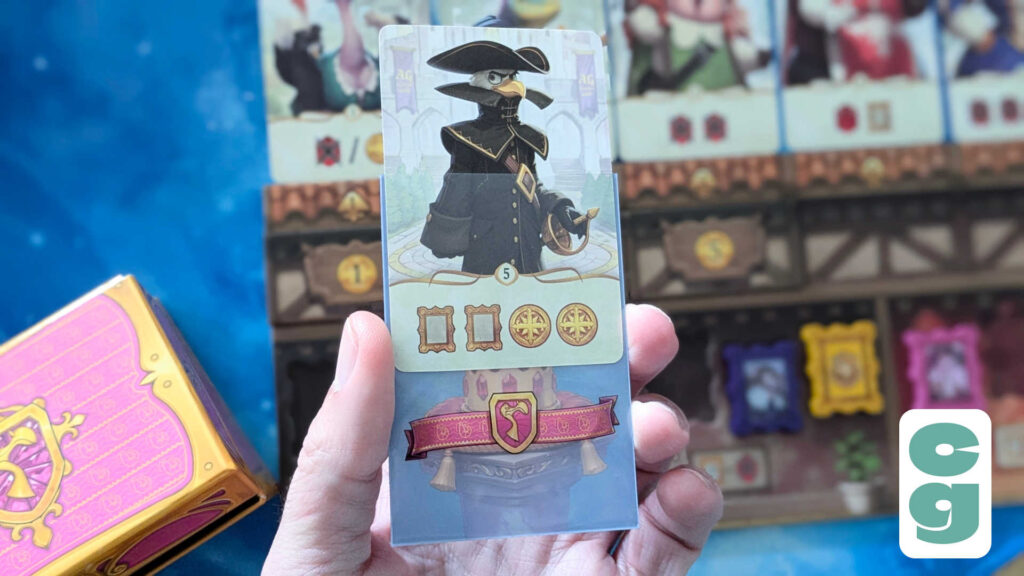
When a card is purchased, it’s sleeved with your family’s crest and color shown on the front, then placed face down in the shared deck, building it for the next phase. You can see a purchased card being sleeved in the image above.
The next player takes their turn at recruiting, and so on until all players have recruited once (though this round happens twice on the first round of the game), at which point the next phase begins.
Reveal
In the reveal phase, the shared deck is shuffled and the top card is revealed. Its effect is immediately applied, then the next card is revealed and so on, until the shared deck has been completely revealed.
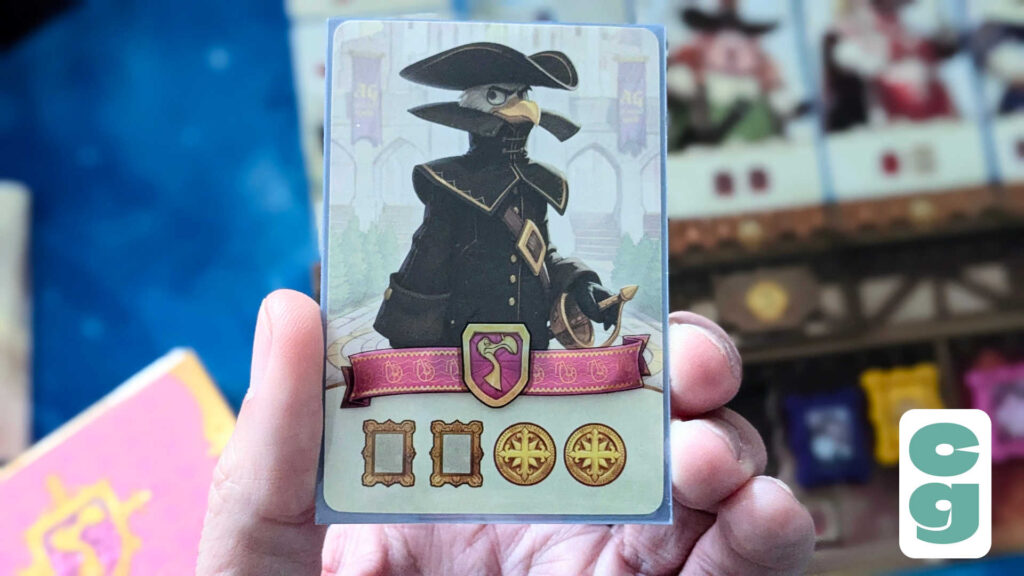
If a mercenary card is revealed, the player who purchased it (identified by the fact that their family portrait is on the sleeve) carries out its effect. In the above image, we can see that the card we previously bought and sleeved has been revealed; its effect is shown at the bottom of the card. The symbols here denote that a portrait can be moved to the next available space in either direction (any portrait, not just the one belonging to the pink player), either twice, or two different portraits can be moved once. It also has two coin symbols, meaning the pink player also earns two coins. If an event card is revealed, rather than a mercenary, all players must abide by its effect, if applicable.
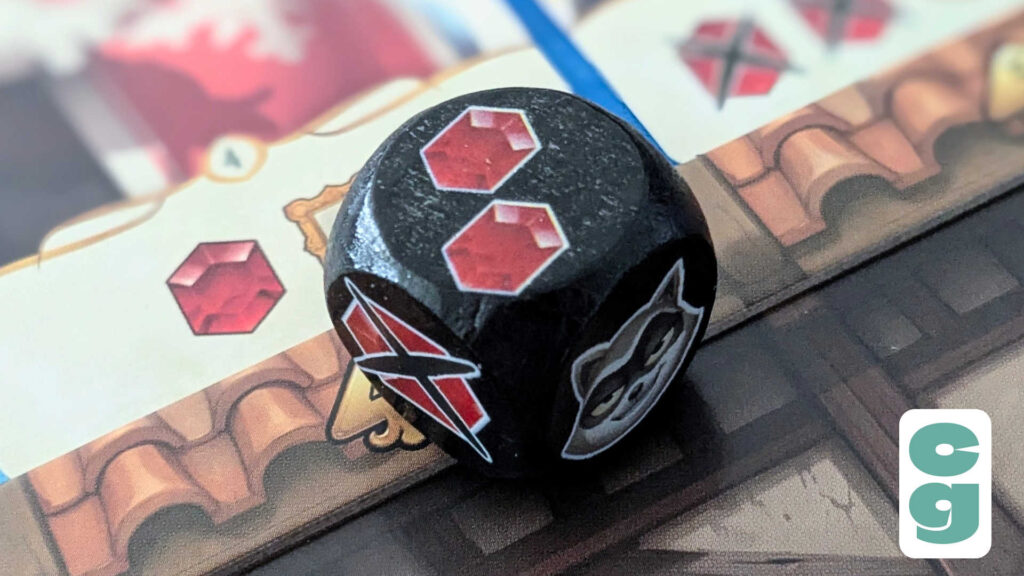
It’s here that the really exciting stuff happens, with different symbols on cards you’ve bought allowing you to gain rubies, force other players to lose rubies, gain coins, move portraits in the gallery, roll the magic die (a six sided die with a multitude of effects, shown above), or even give players Masked Bandit tokens, which can leave them susceptible to burglary events, for example.
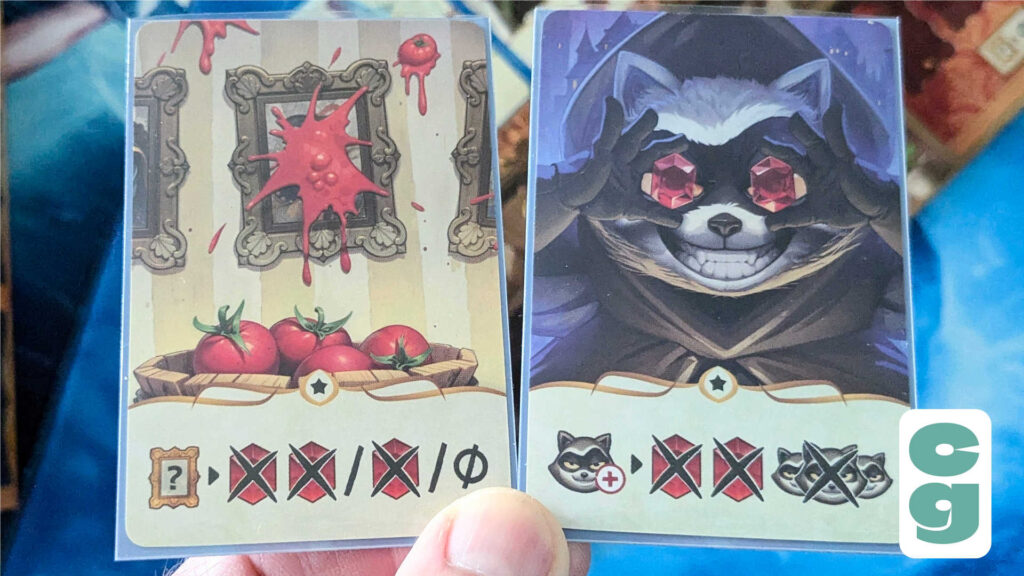
Event cards can be beneficial, but tend not to be; though the Bribery cards allow you to spend money to return Masked Bandits to the supply, or have a chance to roll the magic die (which can also be done if the Helping Hand event is revealed), mostly you’ll come up against Burglary cards (which cause the player with the most Masked Bandits to lose rubies; shown on the right in the above image), or Scandals (the card on the left in the image above), which make players lose different numbers of rubies depending on their position in the gallery.
It’s worth noting that at any time, if you don’t have enough rubies to pay for a card or player effect which causes you to lose them, you can sell your family heirloom immediately for 10 rubies. The heirloom stays in front of you as a reminder, and if you get into a situation where a ruby debt can’t be paid once the heirloom is sold, you are out and the game will end early, once other players have finished the current round.
End of the Round
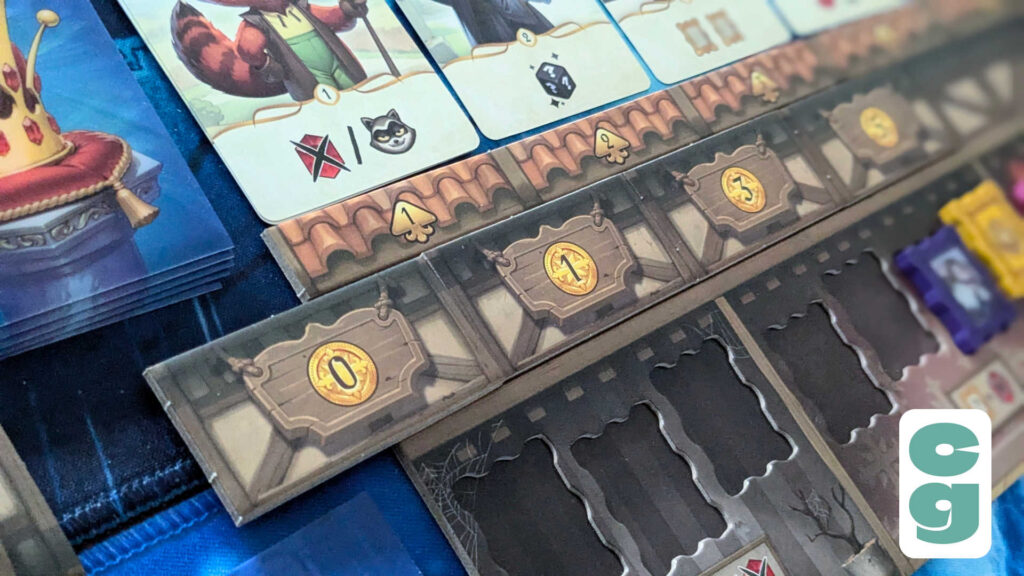
Assuming all players are still active once the reveal phase is finished, the shared deck is flipped over and placed facedown, a new event card is drawn from the event deck and added to the shared deck (without revealing it!), a 0 recruitment cost tile slides onto the track to push the others to the right (as previously mentioned, and shown above), and then the recruit phase begins once more.
End of the Game
At the end of the fourth round, the game ends. The most influential player gains one ruby, the player with the most coins gains one ruby, and the player with the most Masked Bandits loses one ruby. If a player still has their heirloom, it’s worth 10 rubies. The player with the most rubies wins, and is crowned the first ruler of the new kingdom.
Is For a Crown Fun to Play?
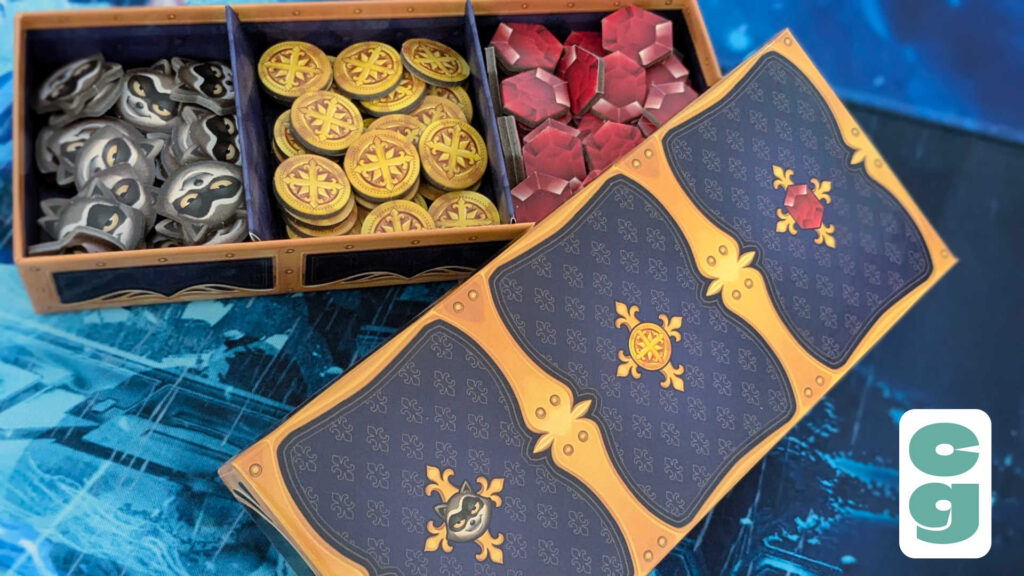
Given the slightly convoluted setup when first playing, I was concerned that For a Crown would be fiddly to learn and play, but those fears soon subsided once the game got underway. It’s also only the first time you play that the game is slightly daunting to set up; once all components are punched and sorted into the individual chests (or the shared chest for the tokens, shown above), each subsequent play is set up quickly and easily, and storage is a dream, with not even a single component ever being out of place when stored.
The game itself is so much fun, with a nicely straightforward level of choice and light strategy in recruiting, followed by an exciting reveal phase, which is where so much of the fun and charm of For a Crown is revealed. The way that the shared deck building aspect is implemented is nothing short of genius, and it’s an incredibly addictive mechanic which just doesn’t seem to lose its sparkle even after multiple games are played.
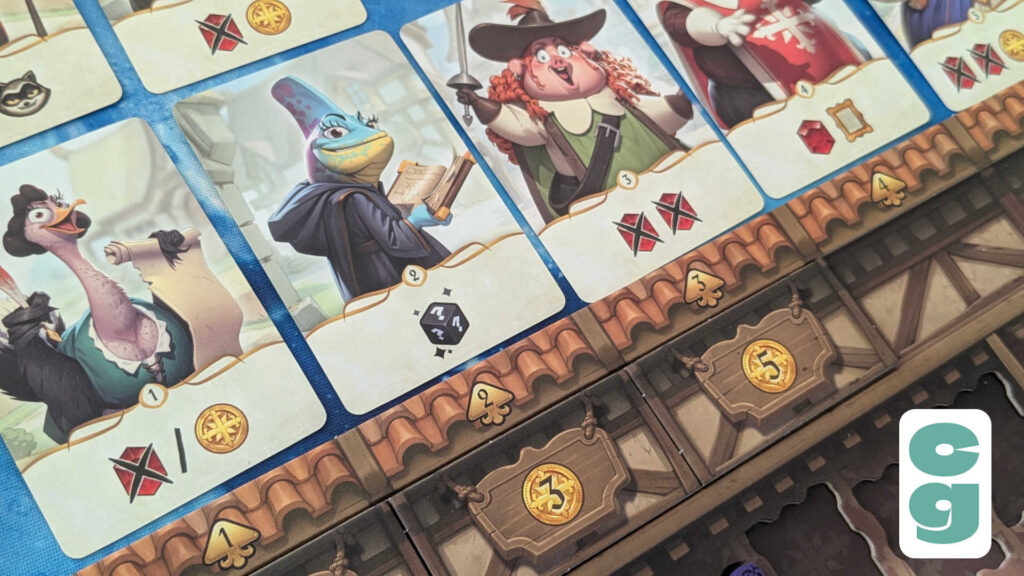
I was concerned that the individual player sleeves may show wear and tear after many repeat plays, but the game is thoughtfully packaged with a reasonable number of spare sleeves, so if damage does occur from overuse, there’s already a solution. Longer term, and for players who really do get a lot of use from their copy of For a Crown, this may become an issue, but for now it doesn’t seem to pose a problem.
There’s some elements of the card effects which have a streak of meanness to them, and I’m usually not a fan of “take that” mechanics, but the table talk and interaction between players, as well as these card effects being relatively minor in the grand scheme of things, seems to mitigate the potential bad feelings that these aspects of a game can sometimes cause. It also helps that player positions with their rubies are kept secret, so you never feel like you’re out of the running in terms of winning the game, as you can only make educated guesses about the success (or not!) of other players.
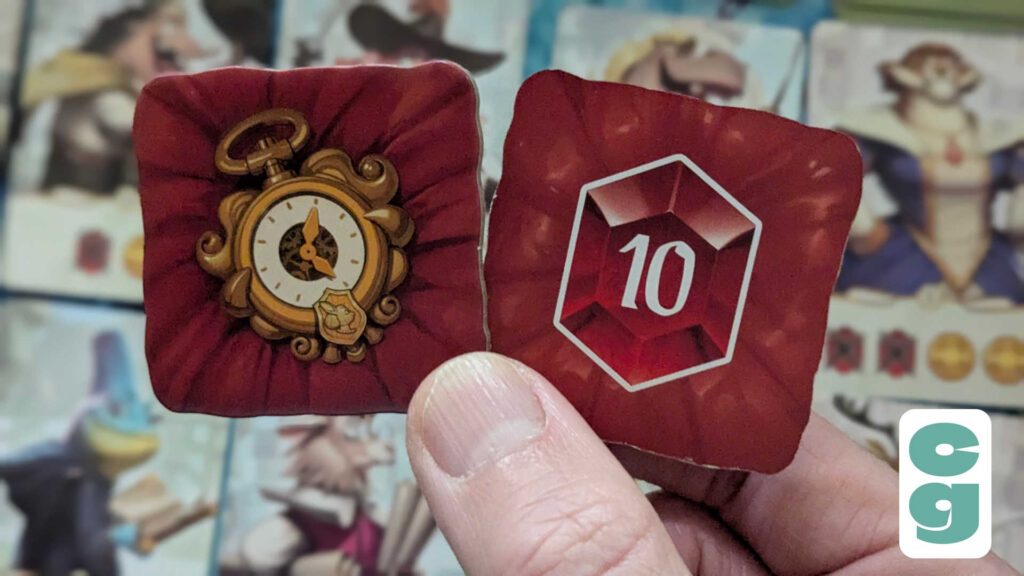
That is, until someone sells their heirloom (both sides of an heirloom token are shown above), which is always a fun moment, and reveals a lot about a player’s position. That said, it can be recovered from, and often is; I’ve seen players sell their heirloom relatively early and still win a game of For a Crown, which speaks volumes about the game’s balance and the ways in which players can succeed. It’s also worth noting that of course, multiple players may have to sell their heirlooms over the course of the game, and it’s always fun when it happens.
For a Crown really is an excellent game, and a pleasant surprise; though, charming illustrations and tactile components aside (including a completely text-free design throughout), it doesn’t initially appear to be anything special, its unique mechanics and simple gameplay really do set it apart from other deck building titles.
The Card Gamer Verdict
A unique and lavishly produced game, For a Crown is thankfully more than just an aesthetically impressive game. It’s incredibly easy to learn and play, and the shared deck building aspect is especially unusual and very compelling.
There’s a great deal of charm and a lot of player interaction with the card effects, and For a Crown is a game which, with its tactile design and clever mechanics, should be a firm favorite amongst families and players of all skill levels for some time.
Though there’s some “take that” style mechanics that often frustrate in other titles, they don’t feel as nasty or severe in For a Crown, which keeps players engaged right up until the counting of rubies at the end of the game.
Want to check out other standalone games that we’ve played and can recommend? Take a look at our Adventure Time Card Wars, The Fellowship of the Ring: Trick-Taking Game or Mindbug: Beyond Evolution reviews.

Jason Brown
This article may contain affiliate links. If you use these links to purchase an item we may earn a commission. Thank you for your support.

